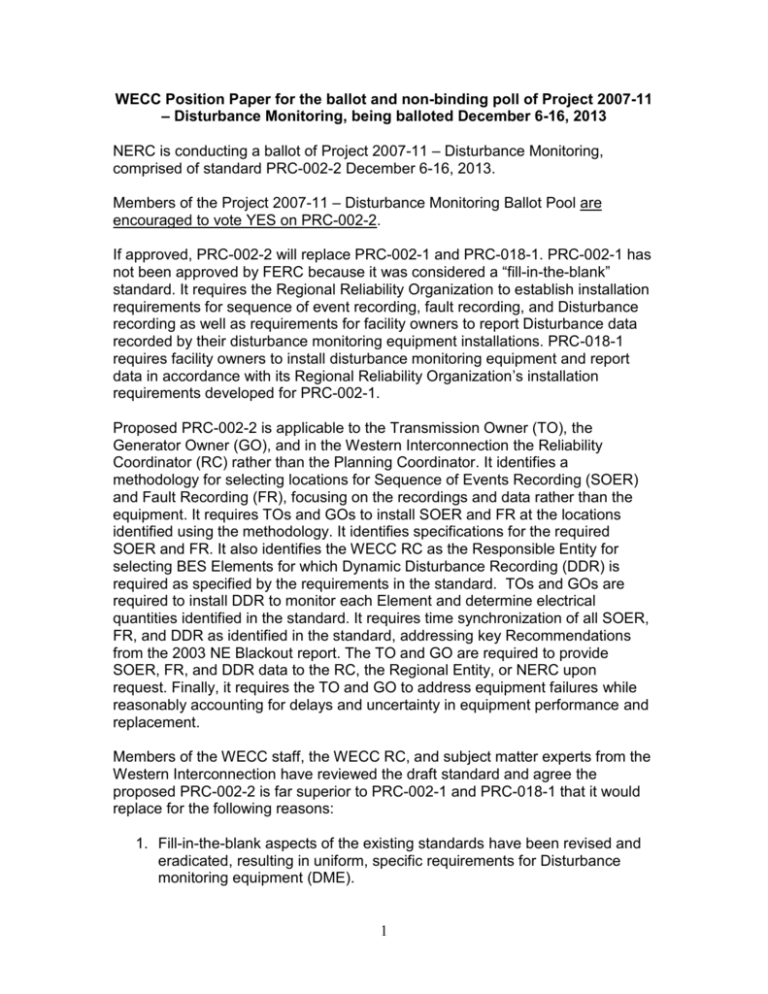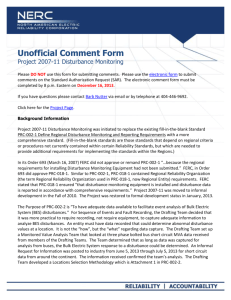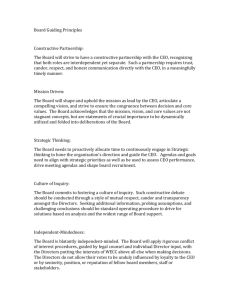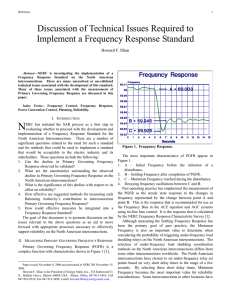2007-11 12-06-13 WECC Position Paper on PRC-002-2
advertisement

WECC Position Paper for the ballot and non-binding poll of Project 2007-11 – Disturbance Monitoring, being balloted December 6-16, 2013 NERC is conducting a ballot of Project 2007-11 – Disturbance Monitoring, comprised of standard PRC-002-2 December 6-16, 2013. Members of the Project 2007-11 – Disturbance Monitoring Ballot Pool are encouraged to vote YES on PRC-002-2. If approved, PRC-002-2 will replace PRC-002-1 and PRC-018-1. PRC-002-1 has not been approved by FERC because it was considered a “fill-in-the-blank” standard. It requires the Regional Reliability Organization to establish installation requirements for sequence of event recording, fault recording, and Disturbance recording as well as requirements for facility owners to report Disturbance data recorded by their disturbance monitoring equipment installations. PRC-018-1 requires facility owners to install disturbance monitoring equipment and report data in accordance with its Regional Reliability Organization’s installation requirements developed for PRC-002-1. Proposed PRC-002-2 is applicable to the Transmission Owner (TO), the Generator Owner (GO), and in the Western Interconnection the Reliability Coordinator (RC) rather than the Planning Coordinator. It identifies a methodology for selecting locations for Sequence of Events Recording (SOER) and Fault Recording (FR), focusing on the recordings and data rather than the equipment. It requires TOs and GOs to install SOER and FR at the locations identified using the methodology. It identifies specifications for the required SOER and FR. It also identifies the WECC RC as the Responsible Entity for selecting BES Elements for which Dynamic Disturbance Recording (DDR) is required as specified by the requirements in the standard. TOs and GOs are required to install DDR to monitor each Element and determine electrical quantities identified in the standard. It requires time synchronization of all SOER, FR, and DDR as identified in the standard, addressing key Recommendations from the 2003 NE Blackout report. The TO and GO are required to provide SOER, FR, and DDR data to the RC, the Regional Entity, or NERC upon request. Finally, it requires the TO and GO to address equipment failures while reasonably accounting for delays and uncertainty in equipment performance and replacement. Members of the WECC staff, the WECC RC, and subject matter experts from the Western Interconnection have reviewed the draft standard and agree the proposed PRC-002-2 is far superior to PRC-002-1 and PRC-018-1 that it would replace for the following reasons: 1. Fill-in-the-blank aspects of the existing standards have been revised and eradicated, resulting in uniform, specific requirements for Disturbance monitoring equipment (DME). 1 2. Clearly identifies the locations where DME recording is required. 3. Identifies the recording requirements and specifications without specifying equipment. 4. Aligns with capabilities of existing technology and application of DME. 5. Leverages installation of DME in the Western Interconnection such as the Western Interconnection Synchrophasor Program (WISP) synchrophasor implementations. Members of the standard drafting team from the Western Interconnection leveraged the work of the WECC Joint Synchronized Information Subcommittee (JSIS) and the JSIS guideline document for Placement of Synchronized Dynamic Monitoring Equipment, while isolating locations that would provide value for the purposes of disturbance monitoring. The standard drafting team worked to ensure that the requirements align with existing technologies, reliability needs, and cost effectiveness for the TOs and GOs. Drafting team members from the Western Interconnection worked to ensure that the standard reflects the needs of the western stakeholders and they believe that many of the current PMUs installed as part of the WISP are likely to meet many of the location requirements for DDR in PRC-002-2. Subject matter experts from the Western Interconnection have reviewed the specifications required of the SOER, FR, and DDR and concur with the requirements. As drafted, the standard identifies the specifications but does not require a specific type of equipment. The WECC RC agrees with the applicability identified in section 4.1.3 and the rationale that the Reliability Coordinator, rather than the Planning Coordinator, is the entity in the Western Interconnection with the best wide-area view of the BES and most suited for determining the Elements for which Dynamic Disturbance Recording is required. For these reasons WECC will be voting to approve PRC-002-2. A complete copy of the proposed standard and associated materials can be viewed at: http://www.nerc.com/pa/Stand/Pages/Project_2007-11_Disturbance_Monitoring.aspx If you determine that you will vote no, it is important that you provide a comment with your vote indicating the reason(s) why you voted no and suggested modifications that would make the standard acceptable. Recent revisions to the NERC Standards Processes Manual require that negative ballots be accompanied by comments explaining the reason for the no vote for the vote to be counted in the determination of consensus. Balloters wishing to submit comments with their ballot must do so via the electronic comment form available from the project page identified above. 2 In addition to the ballot, a non-binding poll of the Violation Risk Factors (VRFs) and Violation Severity Levels (VSLs) is being conducted. WECC staff is not aware of any concerns with the proposed VRFs and VSLs. If you determine that you will vote no on the non-binding poll of VRFs and VSLs, it is important that you provide a comment with your vote indicating the reason(s) why you voted no and suggested modifications that would make the VRFs/VSLs acceptable. All WECC entities that are registered in the Project 2007-11 – Disturbance Monitoring Ballot Pool are urged to cast their ballots prior to the close of the ballot period. 3








